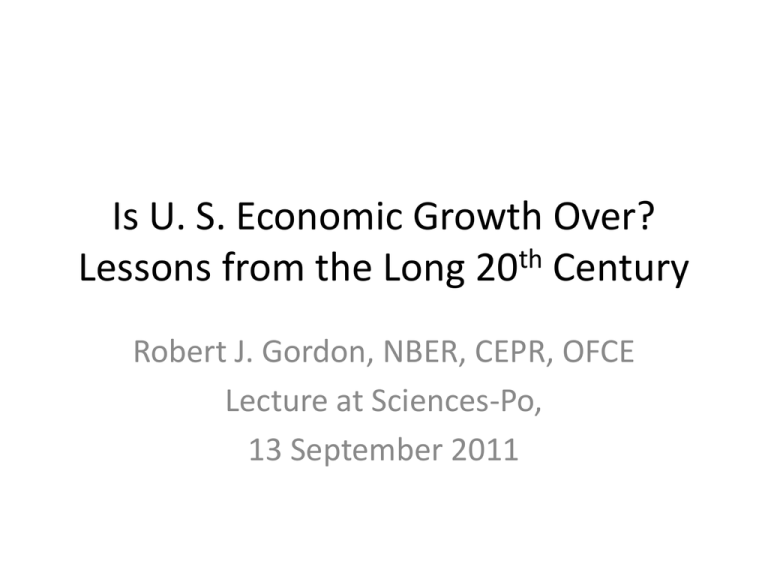Is US Economic Growth Over? - OFCE
advertisement

Is U. S. Economic Growth Over? Lessons from the Long 20th Century Robert J. Gordon, NBER, CEPR, OFCE Lecture at Sciences-Po, 13 September 2011 Thank You for the Invitation • Perhaps my 50th visit to Paris, the first in 1957, then 1963 honeymoon • From my first contact with Paris at CDG baggage claim on Sunday morning, I have been dazzled by the futuristic infrastructure – The American feels like he’s arriving from the third world • My two days here so far, overwhelmed by the rich choice of restaurants, even on Sunday, the ease of obtaining taxis, the bon accueil in the restaurants and the universal bilingualism – Some places have both French and English menus. The food sounds so much better in French. • Impressed by prosperity. Last night I had to call seven restaurants before I could find one which was not fully booked (“Je suis desolee monsieur, nous sommes complets”) • Impressed at the evident value of a great invention, the cell phone, for Paris taxi drivers • One of my hobbies is the history of WWII, which I teach to selected freshmen in a small seminar. Not many Americans, and perhaps not all Frenchmen, know that the most important single person of the 20th century in preserving the beauty of Paris was the German General Choltitz. What is “The Long 20th Century”? • Commonplace term in European History: The long 19th century is from the French Revolution of 1789 to the start of WW I in 1914 • In parallel, the long 20th century for the U.S. is from the end of the Civil War (1870) to now (2010) – For Europe one hears of the “short 20th century” between 1914 and 1991 • Three industrial revolutions (IR) propelled growth. IR #1 (1760-1830), IR #2 (1875-1900), and IR #3 (19852010). – Impact spread over 100, 100, and 25 years? The Basic Hypotheses of This Talk • U. S. economic growth has set the frontier for the developed world since 1890 • The frontier has been pushed forward by IR #1 through 1870 and then the great IR #2 for the whole century 18701970 • For economic growth to continue after 2010, IR #3 will have to live up to the precedent of IR #2, but it will not • Even if innovation continues, it will increasingly meet headwinds that will cancel its effect • Consequence? No net economic growth after 2050. We’ll come close to no net growth in per-capita consumption in the U. S. over the 20 years following 2007. • In the history of the millenia, the great surge of economic growth from 1750 to 2050 will seem to be a remarkable but once-only event. The Main Novelties in This Talk • The inventions of IR #3 were less important than IR #2. • Diminishing returns will make the inventions of IR #3 ever less important. • My really novel proposition. No matter how strong or weak are the remaining future innovations of IR #3, it doesn’t matter • The reason is that the U. S. economy faces five headwinds so important and pervasive that no conceivable industrial revolution could guarantee progress in the consumer standard of living over the next 20 years. The Five Headwinds Fighting Innovation As a Source of Growth • Inequality: growth in median income is much slower than in statistical averages for income and consumption per capita • Globalization linked with IT: Hurts the leading nation more than others. Those radiologists in India. • Environment: Payback for past growth, sacrifice for emerging market growth (is it fair?) • Dysfunctional U.S. educational system (but is France much better in international PISA test scores?) • Twin deficits: consumer and government debt overhang. However slow is growth in production per capita, consumption per capita will grow slower. How Could Economic Growth Be Over? • Here are some immediate qualifications. • This is just about the U. S., not about France, Japan, or any emerging market country where growth proceeds apace. The only mention beyond the U. S. will be a remark or two about France. – The title is deliberately outrageous. But by the end you will start to think, the end of U. S. economic growth could actually happen quite soon. Particularly in consumption per capita for the median household. – The main point of this lecture is how American economic growth rested for more than a century (1870-1970) on the “Great Inventions” of the Second Industrial Revolution (IR #2). – The inventions of the third industrial revolution (IR #3) were less important overall. Importance greatest in 1985-2000 and less so after 2000. Diminishing returns has set in. Outline of Talk • Distinction between three IR’s – IR #1 (1760-1830) – IR #2 (1870-1900) [THE BIG ONE!] – IR #3 (1985-2010) [HOW BIG BY COMPARISON?] • The pivotal year 1870 – How much progress by 1870? – The conditions of life and work in 1870 • The value of IR #2 is measured by how much life changed between 1870 and 1970. – Basic message: we’ve picked the low-hanging fruit of the basic post-1870 transformation in the standard of living A Brief Word on IR #1 (1760-1830) • The Great Inventions were: – Steam Engine • Set on its side, the SE created the railroad • And the steam ship – Cotton gin – Power-operated machines (power spindle and loom) • Remarkably Little Response of MFP Growth • Brad de Long: “Compared to the 20th Century growth, all earlier centuries were standing still.” (not true of 1870-1900 when growth was faster than 1900-1929) Pre-1844: Slowness of Communications • Communication speed limited by the horse and the sail • The famous example: January 8, 1815 Battle of New Orleans fought after the December 24, 1814 Ghent peace treaty • Even the RR and steamship would have made no difference • The difference was made by the telegraph (1844) and undersea cable (1858, 1866) – 1850 30 days from NY to SF – 1860-61 10 days by short-lived Pony Express – Then instantaneous • Humility for internet fans as a Great Invention, 1844 was the greatest leap in the history of communications The Beginning of Progress before 1870: Farming Productivity • In 1830 farmers sowed by hand, cultivated by hoe, cut grains with a sickle, and threshed with a flail. • Most farmers still used wooden plows, which required more human energy than iron plows. • Iron plow invented 1814, John Deere’s steel plow 1850s, Cyrus McCormick’s reaper 1834 – Nothing self-propelled before 1870 Why is 1870 the Pivotal Year for This Talk? • End of Civil War, U. S. economic growth really took off • The basic data series for the U. S. economy begin in 1869 • The epochal event: May 1869, the joining of the transcontinental railway, the golden spike, silver hammer • The instantaneous telegraph transmission of the one-word message DONE! not just to US and Canada but also to UK. The Golden Spike and the Silver Hammer, May 14, 1869 • This was the first time in human history that news of an event of widely recognized importance was greeted with such celebration by so many people at the same time. • Across the nation, bells pealed. It was said that more cannons were fired in celebration than ever took part in the Battle of Gettysburg. • So far had communications come since the Battle of New Orleans in 1815. • But progress had just begun. The great IR #1 invention of the railroad had laid only 60,000 miles in the U.S. by 1870, compared to its ultimate spread of 250,000 miles in 1920 – The century-long influence of IR #1 was still happening The Quality of Life and Work in 1870: Our Indirect Measure of IR #2 Impact • Many of the differences between 1870 and 2011 lie not just in what we consume, but also in the quantity and quality of work, youth, and old age. – And by the “quality of work” we need to pay equal attention to the 1870 male who made his income by doing hard physical labor, often outside exposed to the elements. – and the 1870 female who with few exceptions toiled inside the home in a boring and repetitive life marked by unbelievable effort and drudgery. • Our examination of life in 1870 indirectly becomes a way of viewing the improvement in the standard of living and working since then, largely achieved by IR #2. Demography and Spending in 1870 • Over 80 percent of adults were married couples, almost always with children, in contrast to less than 50 percent married couples today. • The population was roughly 80 percent working class, with the remaining 20 percent middle class and a few that qualified for the upper class. Our description of life in 1870 and afterwards refers to the working class majority. • The three necessities are food, clothing, and shelter – Contemporary surveys of household budgets show that these three categories accounted for fully 85 percent of the consumption of working class households over the four decades between 1870 and 1910. – Virtually nothing spent on durable goods or on services besides housing rent. • Questioning Engel’s Law Of All its Impacts, IR #2 Had Little Effect on Food and Clothing • Americans were surprisingly well fed in 1870. • The caloric content of their diet barely changed from 1800 until the late 20th century, with its current epidemic of obesity. Same calories 1800, 1870, 1930. • Since 75 percent of the population in 1870 was rural, much of the food was produced on the farm. • The 1870 diet of “hogs ‘n’ hominy” was monotonous but impressed foreigners, including recent immigrants, with the large amount of meat consumed – Often at two or three meals per day, as compared to workingclass British and European households. • James Bryce vs. Jacob Riis as observers of America What Was Different About Food and Clothing in 1870? • U. S. 75% rural, 60% lived on farms • Most food home-produced on farms • Hogs ‘n’ hominy supplemented by home-grown vegetables in summer on farms and in urban gardens • Clothing: most women made their own clothing • Purchased clothing in 1870, 20-to-1 men. By 1929 1to-1. • Huge switch in consumption from fabrics and notions in 1870 to purchased clothing in 1929. • One more piece of evidence that the largest transition in the history of the American standard of living occurred between 1870 and 1929 Housing: Much Progress 1870 to 1930 • Urban tenements. “In most large cities, and in many smaller ones, the more poorly recompensed laborers inhabit tenements.” • High rents, dark or dingy rooms, no toilet or bathrooms. Families crowding 5 family members into three small rooms were forced to accommodate boarders and lodgers, just to make ends meet. • Farm houses, less crowded but still primitive • By 1929 there had been a night & day change Common Features of 1870 Housing, Rural and Urban • First was the lack of enclosed iron stoves that could control heat, invented after 1870. Housewives in 1870 had the open hearth, with all its energy inefficiency that would curl the hair of the modern Sierra Club. • Second, there was no electricity. Light for working and reading at night consisted of lamps fueled by kerosene or whale oil. – Town gas was still a rarity. – One candle produced light equal to about 1/100th of a simple incandescent light bulb. Electric appliances were far in the future. • Third, and most important, there was no running water. Every drop of water for laundry, cooking, and indoor chamber pots had to be hauled in by the housewife, and the waste water hauled out. • One source claims that the average North Carolina housewife in 1870 had to walk 148 miles per year while carrying 35 tons of water. • Water in, water out. Coal or wood in for fires, ashes out. Were summers better than winters in 1870? • Perhaps a trivial item was the lack of window screens, which were invented in the 1870s and 1880s. • The typical farm family in the summer had open windows, through which flies passed in between the animal waste in the yard to the food prepared for humans on the table. • No wonder the house fly was once declared as the “American bird” of the 19th century. Utter Dependency in 1870 on the Horse • In 1872 horses throughout the northeast caught a virulent strain of horse flu and could not be used for work and as a result: – City life came to a standstill . . . Streetcar companies suspended service, undelivered freight accumulated at wharves and railroad depots, consumers lacked milk, ice, and groceries, saloons lacked beer, work halted at construction sites, brickyards, and factories, and city governments curtailed fire protection and garbage collection • A full century after James Watt’s steam engine, why were cities so dependent on horses rather than steam-powered devices? – Disadvantages of steam engines within the narrow confines of cities included the ever-present danger of fires started by sparks, their acrid black smoke, their deafening noise, and their heavy weight which cracked street pavements. More About Horses (and Pigs) • Horses required expenditures each year for food and maintenance equal to their capital cost • The average horse produced 20 to 50 pounds of manure and a gallon of urine daily, applied without restraint to stables and streets. The daily amount of manure worked out to between 5 and 10 tons per urban square mile, all of which required gruesome human labor to remove. • The urban streets of the 1870s were full not just of horses but pigs, which were tolerated because they ate garbage. In Kansas City, the stench of patrolling hogs was so penetrating that visiting Oscar Wilde observed, “They made granite eyes weep.” Why Life Expectancy Was So Low in 1870 • At birth life expectancy was only 45 years in 1870 compared to 79 years recently. – Causes in 1870: infant mortality resulting from poor sanitation, water-transmitted diseases, and contaminated milk. – The first attempts at urban sanitation infrastructure emptied waste not into cesspools but into nearby rivers with no filtration. The theory at the time was that “the rivers cleaned themselves.” • Short life expectancies resulted also from hard physical labor, the ongoing exposure to dwellings that were often too hot, too cold, poorly ventilated, smoky from coal and wood fires and gas or oil lighting, not to mention all those insects passing back and forth through unscreened windows. The Standard of Living Involves Not Just the Quality of Consumption but the Quality of Work • We can rate the “quality of work” as “pleasant” and others as “unpleasant.” • If we describe farming, blue-collar work, and domestic servants as unpleasant jobs, and the rest as pleasant then 87 percent of jobs in 1870 were unpleasant. – By 2010 this percentage had declined to 22 percent. • Most of this transition from unpleasant to relatively pleasant work was completed by 1970. • All of this transition should be credited as an achievement of IR #2 – As one example, think of farm machinery that allowed an enormous decline in the share of the work force in farming, hard outdoor work exposed to the elements The Quality of Work for Women • Already described: hauling those tons of water in and out, plus the coal and wood • Most bread was home-baked, so Sunday was baking day • Monday was laundry day • Tuesday was the day to dry and fold the clothes • Wednesday was the day for sewing and making clothes for mothers and daughters • Virtually no working-class women worked outside the home. Another Great Change: The “Quality of Youth” • Young people below the age of 25 made up 60 percent of the population of 1870. – Few children extended their education beyond the age of 12. – Male teenagers worked, they were not at school, and the labor force participation rate for males aged 16-19 was 76 percent. – Participation by male teenagers was an economic necessity on the farms of the American frontier, where immigrants were dismayed to find that there was no ready supply of farm laborers as in their homelands. – Female teenagers shared the household chores of their mothers. • Think of the leisurely life of today’s video game-obsessed male teenagers and facebook-obsessed female teenagers compared to their hard-working counterparts of 1870. How Did the Great IR #2 Inventions Change 1870 Living Conditions? • The great inventions of IR #2 can be clustered into five groups. Each had a primary breakthrough invention that occurred between 1860 and 1900. • The first was electricity, including both electric light and electric motors. – In the early decades of the 20th century electric motors revolutionized manufacturing by decentralizing the source of power. – After a lag electric motors embodied in consumer appliances eliminated the greatest source of drudgery of all, manual laundry. – Refrigerators eliminated food spoilage, and air conditioning made summers enjoyable and opened the southern United States for modern economic development. The 2nd and 3rd Group of Great Inventions of IR #2 • Second, the internal combustion engine made possible personal autos, motor transport, motor trucks, and air transport. – Derivative inventions include the suburb, superhighway, and supermarket. – Gradually eliminated were many of the ills of 1870, from manure to unplowed snow to rural isolation to the horses themselves. • Third, the rapid spread after 1880 of running water, indoor plumbing, and urban sanitation infrastructure. – To be useful the indoor toilet required running water going in and out to a sanitary disposal facility – Urban sanitation infrastructure was the single biggest contributor to improved health between 1870 and 1929. The 4th and 5th Group of Great Inventions of IR #2 • The fourth set includes petroleum, natural gas, and processes which “rearrange molecules,” including chemicals, plastics, and pharmaceuticals. – Sulfa-based drugs were invented in the 1930s, penicillin during World War II. – Plastics were mainly developed after World War II. • The fifth group consists of the complex of innovations related to entertainment, communication, and information. – We have already hailed the 1844 invention of the telegraph. – Also in this group and qualifying as part of IR #2 are the telephone (1876), phonograph (1877), popular photography (1880s, 1890s), radio (1899), motion pictures (1881 to 1888), and television (1911). • How far we had come by 1942. 4/10 of AFI’s greatest-ever films were made in 1939-42 – Can you name them? How Much Had Happened by 1929! • Most of the benefits had already occurred by 1929. – Urban America by then was electrified – Electricity brought light to city streets and to every dwelling, had made possible washing machines and refrigerators – It made skyscrapers possible through electric elevators, and revolutionized manufacturing by decentralizing the source of power. • What a change even since 1900 – Rodgers and Hammerstein’s song “Everything’s Up to Date in Kansas City” set in 1900 contains the highly relevant line, – “they’ve gone and built a skyscraper seven stories high, that’s as high as a building ought to go.” – The rapid pace of progress since 1870 is symbolized by the contrast between small walk-up buildings in that year and the Empire State Building, completed in 1931. Amazing 1929 factoids about U. S. Motor Vehicles • • • • 6 million cars, trucks, busses produced in 1929 80 percent of the world’s auto production 90 percent of the world’s auto registrations Is it any wonder how the “Arsenal of Democracy” helped to win World War II, the “war of motors”? • Full credit to the Soviets for beating the Germans, but they rode to victory on 400,000 Dodge trucks given to them by American Lend-Lease. While the German supplies were still carried by horsedriven wagons. Added Measures of 1929 Progress • By 1929 in urban America the horses were gone, the manure was gone, the pigs no longer roamed the streets, and farm families were no longer isolated. • Motor transport, and electrified rapid transit in the largest cities, allowed working-class families to escape from tenements to new tracts of single-family homes epitomized by Chicago’s bungalow belt. • By 1929 much of the drudgery had been removed from female existence. – In urban America there was now running water, toilets, bathrooms, and waste pipes that led to modern water filtration and sewage treatment plants. – The open hearth for heating and cooking had been replaced first by enclosed cast iron stoves and by 1929 replaced again by hot-water central heating and early versions of the kitchen range. • The increase of life expectancy in the first half of the 20th century proceeded at triple the rate of the last half. – The invention of antibiotics and CT scans did not improve the length of life at a rate remotely comparable to the earlier public investment in urban sanitation infrastructure. The Benign Role of Government as a Backdrop to IR #2 • Civil War Legislation – Homestead Act, free land – Subsidies for transcontinental railways – Morrill Act for land-grant state universities • Teddy Roosevelt, Progressive Era – Food and Drug Act 1906 (Upton Sinclair Jungle) – Broke up Standard Oil monopoly – Free, open immigration until 1922 • American standard of living propelled by fast population growth, no internal customs barriers – As symbolized by the Sears catalog, buying & selling Enlightened Government Policy, Continued • FDR’s New Deal – – – – Federal Deposit Insurance Social Security, unemployment compensation Glass-Steagall Act (repealed 1999) Put people to work on Federal payroll, compared to Obama stimulus – WPA, Hoover Dam, SF bridges, post offices, national parks • Truman’s Marshall Plan and GI Bill • LBJ – Medicare – Civil Rights • Throughout postwar, govt support of research, computers, internet Economic Growth as Created by IR #2, 1929-70 • Television, first shown 1939, big cities 1946-51 • Interstate highways 1958-72 • Air travel – We’ve never gone faster than the 1958 Boeing 707 – Reversal of speed, end of US space shuttle • Spread of air conditioning, opening the south • GI Bill, golden age of higher education, the example of California How Does IR #3 Measure Up? • Definition, let’s be generous – It didn’t start in 1995 with Windows 1995 & IE – It didn’t start in 1982 with the IBM PC – It started in 1946 with the ENIAC mainframe • The main point is that IR #3 gains for business productivity and human welfare started much earlier than most people recall. • Progress was slow at the start because computers were mainframes that occupied entire buildings, used vacuum tubes rather than transistors, ran hot, required enormous air conditioning investment • By 1961 telephone bills were being prepared with punch cards and card sorters • In graduate school during the mid-1960s we punched our own cards and hand-fed them into the computer – my 1967 PhD thesis includes more than 100 pages of beautifully formatted computerprinted data tables. The Progress of IR #3 Marked with Personal Memories • • • • • • 1978: My first acoustic coupler and dumb terminal in 1978 1980: My first long-distance electronic co-authorship 1983: My first personal computer with its two floppy drives 1992: The heaven of Wordperfect 6.0 August 1993: My first e-mail 1994-95: Never since were e-mail messages so frequent or so long • Moving from personal anecdotes to aggregate data, the oneshot nature of the late 1990s dot.com boom: – The share of total GDP taking the form of IT investment, including software and telecommunications, experienced a one-time increase from 3.6 to 4.8 percent between 1995 and 2000 – But was just 3.8 percent in 2007 and 3.7 percent in 2010. • This is part of the case that IR #3 is slowing down already Contributions of IR #3 to Business Productivity • It started before the internet – 1980s: ATM machines and bar-code scanning – 1990s: Replacing paper library catalogs and paper parts catalogs at auto dealers and repair shops – Wal-Mart and its famous distribution efficiency • Cell phone and internet were both the marriage of computers and communications – Cell phone for calls, not data, established by late 1990s – PCs in offices had T-1 lines, not dial-up, back in mid1990s. Broadband arrived in homes 1992-96 and created the e-commerce revolution How Important Were IR #3 Innovations during 2001 – 2011? • A thought experiment to value IR #2 vs. IR #3 • Choice A is that you get to enjoy your laptop with all the software that had already been invented in 2001, including windows, internet explorer, and Amazon, and you get to keep running water and indoor toilets. But you can’t use any electronic invention introduced since 2001. • Choice B is that you get everything invented in the past decade, right up to facebook, twitter, and the ipad 2, but you have to give up running water and indoor toilets, you have to go outside to an outhouse, and you have to carry your water for bathing and cooking in buckets and pails in from an outdoor well, and if you want hot water you have to heat it on an open-heart fireplace that you have to feed with wood or coal that you must carry inside in buckets and pails. And there’s no cheating, you have to do it. • Which do you choose? Thinking About IR #2 vs. IR #3. Which Do You Value More? • The introduction of GPS navigation screens on autos compared to the invention of the auto itself. • The introduction of the cell phone compared to the invention of the phone itself and the telegraph. • The invention of home-streaming of movies to the invention of the motion picture itself. • The invention of the ipod to the invention of the phonograph. • The invention of the microwave oven to the replacement of cooking on the open hearth by the enclosed cast iron stove and later the kitchen range. • Icemakers in refrigerators compared to the invention of the refrigerator or even the icebox. • The conversion of card catalogues in libraries to electronic screens with the invention of electric light that made it possible to read books at night. And Yet That Game Didn’t Include So Many Benefits of IR #2 • Indoor plumbing • Urban sanitation infrastructure – Conquest of water-borne diseases – Near-elimination of infant mortality • The end of the female’s subservient role as a carrier of water and coal • The change of male jobs from unpleasant to pleasant. Negatives of the Internet • Closing of options for consumers – Bankruptcy of Blockbuster video rental chain – Bankruptcy of Borders book store chain • Detrimental effects on children – News report: “Allison Miller, 14, sends and receives 27,000 text messages per month.” – Small problem, Allison is getting B grades, not A grades, on her report card. She blames not being able to concentrate on homework. Distraction of Electronic Media for Children • 1998: 7.3 hours per day with media (including multi-tasking) • 2009: 10.5 hours per day • Time reading books: unchanged • Dispatch from Arizona. A school district spent a huge amount to computerize classrooms, convert teaching of basics to computer instruction • Result? No improvement in test scores Summary of the Case Until Now • The pace of economic growth has been propelled by the three IR’s • IR #2 is a much bigger deal than IR #3 • The expansion of the standard of living frontier is less under IR #3 • Most of the big benefits of IR #3 for business productivity happened early, before 2001, with bar-code scanning and electronic catalogs • The implication is that the scope for future productivity growth matching the rate from 1870 to 1970 is quite limited What About the Future of IR #3? The Folly of Forecasting • In 1876 an internal memo at Western Union, the telegraph monopolist, said that “the telephone has too many shortcomings to be considered as a serious means of communication.” • In 1927, a year before the first talking motion picture, the head of Warner Brothers said “Who the hell wants to hear actors talk?” • In 1943 Thomas Watson, president of IBM, said “I think there is a world market for maybe five computers.” • In 1981 Bill Gates, defending the capacity of the firstgeneration floppy disk, claimed that “640 kilobytes out to be enough for anyone.” But We Don’t Need to Forecast • Even if IR #3 continues to deliver inventions, the tailwind of technology is confronting five headwinds. • Recall that we’re talking about the U. S. only, but I’d be interested in your reaction – how many of these headwinds does France face? • The five categories again: inequality, globalization, environment, education, debt The Stunning Implication of Rising U. S. Income Inequality • Let’s say U. S. income per capita is growing at 1.5 percent per year while French is growing at 1.3 percent per year. • The U. S. is doing better, right? Wrong? • Income inequality has been rising in U.S. but not in France • The U.S. growth of 1.5 percent for the entire population translates into only 0.9 percent for the bottom 99 percent. • Don’t believe it, look at the data of Piketty-Saez, two world-famous French economists Table 1. Real Annual Income Growth by Groups, 1993-2008 Average Income Top 1% Incomes Bottom 99% Incomes Real Annual Growth Real Annual Growth Real Annual Growth Fraction of total growth (or loss) captured by top 1% (1) (2) (3) (4) 1.30% 3.94% 0.75% 52% 4.0% 10.3% 2.7% 45% -6.0% -16.8% -3.3% 57% Bush Expansion 20022007 3.0% 10.1% 1.3% 65% Great Recession 20072008 -9.9% -19.7% -6.9% 47% Full period 2008 1993- Clinton Expansion 1993-2000 2001 Recession 2002 2000- The U. S. Top Decile Income Share, 1917-2008 Causes of U. S. Rising Inequality • Within bottom 90 percent – Weaker unions – Lower real minimum wage – Globalization • Competition from imports • Outsourcing • Competition from low-skilled immigrants • Within the top 1 percent – Economics of super-stars – Top lawyers, professionals as super-stars – Managers, CEOs paid with stock options, counted in their labor income Decomposing the Top Decile US Income Share into 3 Groups, 1913-2008 CEO Pay versus Average Wage Income, 1970-2006 Top 0.1% Income Shares in the U.S., France, and the U.K.,1913-2007 Second Headwind: Globalization • Explaining the Autor-Katz “polarization hypothesis.” – Upper level, creative, contact essential – Mid-level white collar. Not creative, easily outsourced – Bottom-level, contact essential. Waiters, bartenders, truck drivers, nurses • Inventing the internet has worked against the US. • Instant computer access from anywhere is carving out the mid-level white collar jobs – Replaced by machines – Replaced by outsourcing • Implication for “the end of economic growth”, continued shortfall of median income growth below mean income growth Third Headwind: Environment • Like a massive debt hangover, global warming requires sacrifice of living standards – Carbon taxes – Constraints on which uses of energy are allowed – Household disposable income is diverted into spending on insulation and new energy-efficient cars and appliances which don’t provide services any better than what they replace. • Payback for 140 years of growth created by IR #2 • Advanced countries forced to sacrifice because of catch-up in the emerging fast-growing nations • Controversial analysis about policy implications, uncontroversial that this will slow growth Fourth Headwind: The Dismal U.S. Education Situation • U.S. higher education is much admired, but the main achievement is in the past – U.S. has fallen from 1st to 8th in college completion – Cost inflation in higher education is as significant as in medical care – Costs at state universities rising faster because of state budget shortfalls – Many American students are being priced out of higher education – Who is attending in their place? The 500 Chinese applicants at tiny Grinnell college in Iowa • My story about Asian names in my Econ 311 class – Increasingly, Asian immigrant students are heading home after graduation Even More Dismal is American Primary and Secondary Education • The OECD PISA tests in reading, math, and science • Ranks of US within OECD (37 countries) – Reading #17 (France #22) – Science #23 (France #27) – Math #31 (France #22) • 75 percent of Army enlistees rejected because of poor test scores or previous criminal records • Only 35 percent of American high school students are prepared for college • Much of America’s college participation is in 2-year community colleges which are glorified high schools, with most courses remedial, low graduation rates, and few transfers to 4-year colleges • Outcome: ever more American firms are complaining about inability to find skilled workers, despite 16 million unemployed. – The unemployed are unskilled or those whose skills are now irrelevant – The H1-B visa problem, the immigrants who accounted for 35% of Silicon Valley start-ups Fifth Headwind: Consumer and Government Debt • Household debt as % of disposable income went from 90% in 1995 to 133% in 2007, since then is back down only to 119%. Year after year of deleveraging will follow • Federal government deficit the result of – Irresponsible Republicans, cut taxes while starting two wars with no revenues to pay for them – Then the deep revenue hole from the great recession • Democrats equal blame: their role in state government deficits. Implications of the Five Headwinds on Future Economic Growth • Inequality will hold median income growth below average income growth • Globalization will continue to hollow out the previous routine white and blue collar jobs in the former middle class • Environment will either be ignored or will slow growth in consumption of non-energy-related products • Poor education will lead to more outsourcing, more unemployed high-school dropouts, and increased movement of American firms to foreign locations • Consumer debt means that consumption will grow slower than income; government debt means that more people will lose their jobs from expenditure cuts, and incomes after taxes and transfers will decrease relative to incomes before taxes and transfers. Conclusion: Let’s Buttress This History With Some Numbers • You’re about to see bar charts tracing U. S. economic growth since either 1870 or 1891. • We’ll distinguish different concepts of economic growth – – – – Real income per capita Real consumption per capita Average labor productivity Total factor productivity • Both unadjusted and adjusted for changes in capital and labor quality • For each concept we’ll compare history with a coherent forecast for 2007-27 – This does NOT take into account any long-run damage from loss of human or physical capital in the Great Recession Growth in Output and Consumption per capita since 1870 The Consumption-GDP Ratio Since 1869: Why It’s Payback Time Ten-Year Moving Average of GDP vs. Consumption Growth, both per capita The Distinction Between Output per Capita and Output per Hour Explaining the Difference: Growth in Hours per Capita Labor Productivity vs. Non-adjusted MFP Growth Adjusting for Improvements in Labor and Capital “Quality” The Bottom Line: The Different Chronology of Consumption and MFP Unadjusted MFP Growth By Itself The Message of the Charts • The underlying assumption is most optimistic: unadjusted MFP growth in 2007-27 will be faster than 1988-2007 and indeed faster than at any time since 1964 • Yet growth in consumption per capita will be slower than at any time since 1870, except for 1913-28 (surely a phony number) • Why the difference? – End of growth in educational attainment – Reduced hours per capita due to retiring baby boomers – Reduced C/Y ratio due to indebtedness overhang But An Ever Bigger Message • Projected growth of consumption per capita of 1.0% ignores growing inequality. For the bottom 99 percent of the income distribution, it could be 0.5% or less. • Consumption could also be held down by government debt reduction due to pension reform, slower growth in transfers, higher taxes • We’ll be perilously close to zero growth in consumption per capita over the next 20 years, even starting from a 2007 base that ignores the destruction in human and physical capital that has occurred since 2007 as a result of the Great Recession Conclusion: Now It’s Your Turn • You might ask, what are my solutions? • I would rather think about solutions by considering differences between countries. • Does the rate of technical advance for IR #3 matter for France or other nations? Is the US still the technological leader? • Do you see productivity growth in France slowing down further or speeding up? • Which of the five headwinds does France share with the U. S.? – Inequality, gloobalization, environment, education, and debt • Let’s start talking . . .








